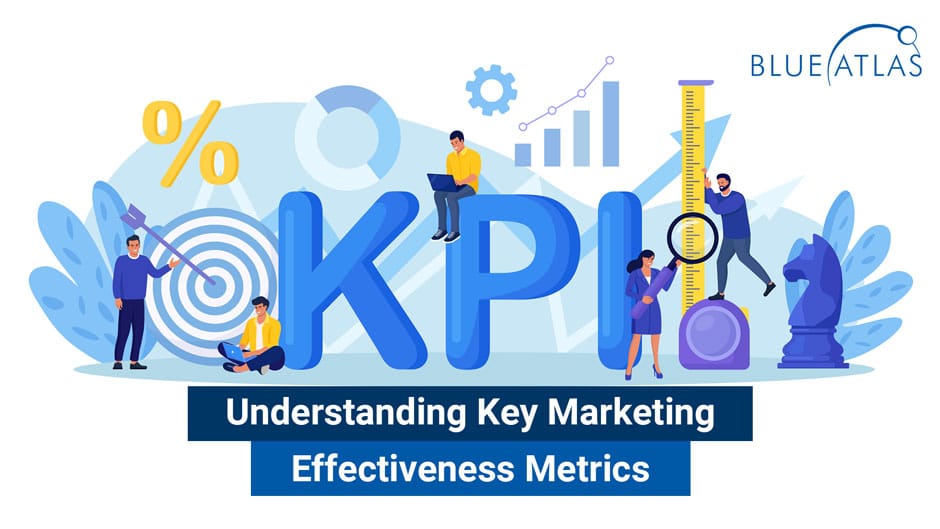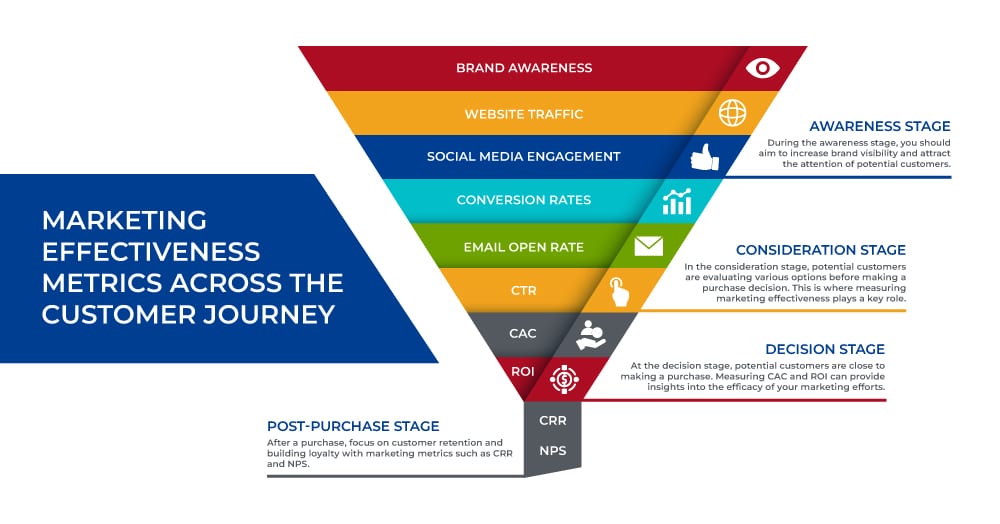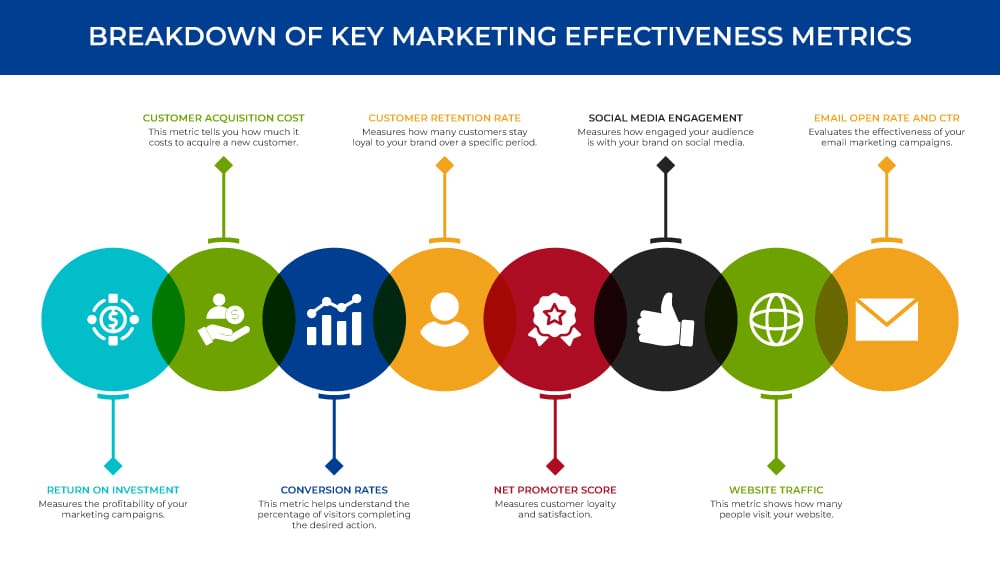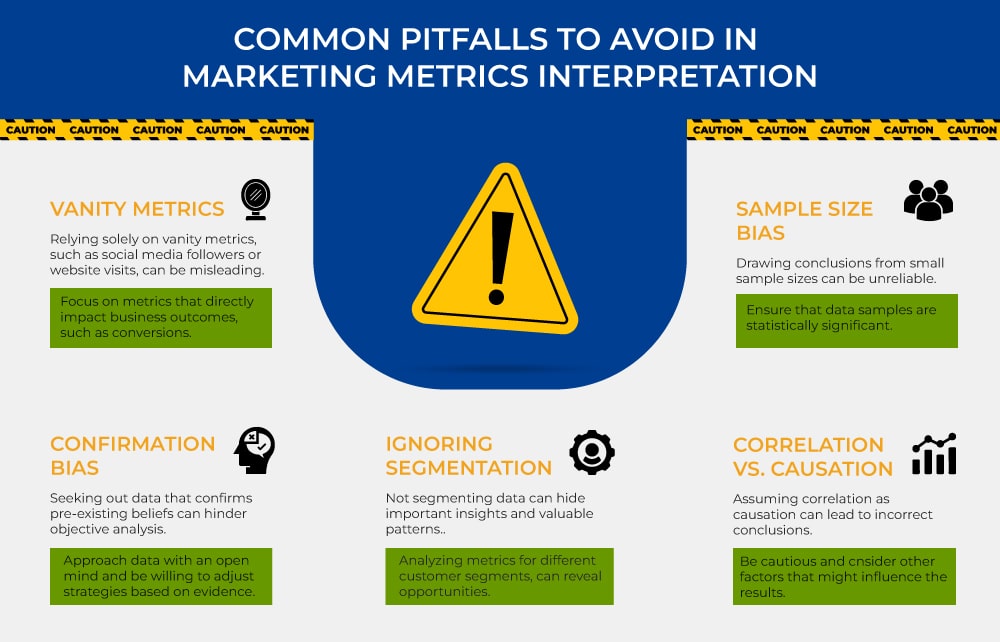Understanding Key Marketing Effectiveness Metrics

In today’s business world, where data-driven decisions are paramount, understanding marketing effectiveness metrics is like having a secret weapon. These metrics, when correctly used, can guide strategic decisions, measure progress, and provide insight into your customers’ behavior. This article is your roadmap to understanding and leveraging these critical tools for business success.
Understanding the Concept of Marketing Effectiveness Metrics
The concept of marketing effectiveness metrics can be compared to the dashboard of a car. Just as you wouldn’t drive without monitoring your speed, fuel levels, or engine status, navigating your marketing strategies without keeping an eye on critical metrics can lead to unfavorable outcomes.
Marketing effectiveness metrics are the quantitative values used to measure and evaluate the performance of marketing efforts. They serve as the compass guiding marketers towards their organizational goals. Whether it’s customer acquisition, brand awareness, sales growth, or any other marketing objective, it’s the metrics that reveal if your marketing activities are propelling you towards your targets or if they’re falling short.

Understanding Metrics in Context
While understanding the metrics themselves is crucial, it’s equally important to understand them in the context of your specific business and marketing objectives. Every organization will have unique targets and what might be a crucial metric for one business might not be as relevant for another. As a business, you need to identify and focus on those metrics that align most closely with your goals and objectives.
At the same time, these metrics are not static. They need to be evaluated and updated continually to stay aligned with your evolving business landscape. A good understanding of marketing effectiveness metrics paves the way for agility and adaptability in your marketing strategies, two essential ingredients for sustainable success in today’s dynamic business environment.
Exploration of Key Marketing Effectiveness Metrics
Let’s unpack some of the key marketing effectiveness metrics and understand how they influence your business strategies.
- ROI (Return on Investment): ROI measures the profitability of your marketing campaigns. It shows which marketing efforts are making money and which ones may be draining your budget.
- Customer Acquisition Cost (CAC): This metric tells you how much it costs to acquire a new customer. By keeping an eye on CAC, you can identify whether your customer acquisition strategies are financially sustainable.
- Conversion Rates: This metric helps understand the percentage of visitors completing the desired action. Be it signing up for a newsletter, purchasing a product, or filling out a contact form, conversion rates provide insights into the effectiveness of your calls to action.
- Customer Retention Rate (CRR): Retaining customers is often more cost-effective than acquiring new ones. CRR helps you understand how many customers stay loyal to your brand over a specific period.
- Net Promoter Score (NPS): NPS measures customer loyalty and satisfaction. It asks customers how likely they are to recommend your business to others, providing a direct insight into customer satisfaction.
- Social Media Engagement: Likes, shares, comments – these metrics provide insights into how engaged your audience is with your brand on social media.
- Website Traffic: This metric shows how many people visit your website. Breaking it down further into new and returning visitors can help you understand your website’s reach and your audience’s interest level.
- Email Open and Click-Through Rates: These metrics help evaluate the effectiveness of your email marketing campaigns. High open and click-through rates indicate that your email content resonates with your audience.

What Gets Measured Gets Managed
The metrics mentioned above certainly play a vital role in measuring the effectiveness of your marketing efforts, but it’s crucial to note that they are not the only ones that matter. The landscape of marketing metrics is vast and varied, and it is continually expanding with the emergence of new platforms, tools, and techniques.
Also, keep in mind that there’s an array of industry-specific or campaign-specific metrics that you might need to consider based on your unique business context and marketing goals. For example, an eCommerce business might focus more on metrics like Shopping Cart Abandonment Rates or Average Order Value, while a software company might put more emphasis on Free Trial Conversions or User Onboarding Efficiency.
The key is to select the metrics that are most relevant and valuable to your business. As the saying goes, “what gets measured gets managed,” so choose wisely to ensure your metrics guide you toward your desired business outcomes. Remember, it’s not about collecting data for data’s sake—it’s about measuring what truly matters to your business’s growth and success.
Choosing the Right Metrics for Your Business
Choosing the right metrics isn’t a one-size-fits-all exercise. It’s a strategic process that involves an understanding of your specific business objectives, your target audience, and the nature of your marketing campaigns. Each business is unique and so are its needs and goals. Hence, the metrics that work for one company might not be as effective for another. The secret lies in identifying the most meaningful metrics that are directly aligned with your business objectives.
To determine which metrics are right for your business, start by clearly defining your marketing goals. Are you aiming to increase brand awareness, drive more website traffic, generate leads, or improve customer retention? Each goal will require different metrics. For example, if your goal is to increase brand awareness, you might focus on metrics like social media reach, impressions, and mentions.
On the other hand, if your objective is to generate leads, metrics such as conversion rates, lead quality, and cost per lead will be more relevant. Once you have a firm grasp on your goals, you can select the appropriate metrics that will provide you with the insights you need to gauge your progress and adjust your strategies as needed.
The Role of Metrics in Decision Making
Metrics aren’t just numbers; they tell a story about your business. For example, a low conversion rate could signal that your website’s user experience needs improvement, or a high customer acquisition cost might indicate that it’s time to optimize your marketing spend.
Delve a little deeper and you’ll realize that these numbers are actually narrating the story of your business. They offer a detailed account of your marketing performance, pointing out where you’re winning and where improvement is necessary.
Informed Decision-Making through Metrics
Understanding the stories these metrics tell is crucial because they form the foundation for data-driven decisions, the essence of modern marketing strategy. With this insight, you can tweak your marketing efforts for enhanced effectiveness.
Are customers abandoning their shopping carts before making a purchase? Maybe it’s time to streamline your checkout process. Is one social media platform outperforming the others significantly? Perhaps it’s worth investing more resources there.
The role of metrics in decision-making extends beyond identifying problems. They can also highlight successful strategies that can be leveraged even further. A sudden spike in organic traffic after a blog post goes live might suggest that your content strategy is hitting the mark.
A significant rise in customer retention after a new loyalty program rolls out may indicate a successful initiative. By keeping a close eye on your metrics, you’ll have the data-driven insights needed to guide your marketing strategy and achieve the results you desire. The goal is to turn data into information, information into insight, and insight into business decisions that enhance marketing effectiveness.
Avoiding Common Pitfalls in Using Marketing Effectiveness Metrics

While metrics are invaluable tools, they can lead to misguided decisions if misinterpreted. One common pitfall is focusing too much on vanity metrics (like page views or followers) that look impressive but don’t necessarily impact your bottom line. Instead, focus on actionable metrics that tie directly to your business goals.
Navigating Beyond Vanity Metrics
Indeed, vanity metrics such as page views, social media followers, or likes, while they may boost team morale, often don’t provide meaningful insight into your marketing effectiveness. While it’s certainly good to have a large number of page views or followers, they don’t necessarily convert to sales or engaged customers. They can distract you from the more critical, actionable metrics that directly impact your bottom line, like conversion rates or customer acquisition costs.
Tying Metrics to Business Goals
To avoid the trap of vanity metrics, you need to focus your attention on actionable metrics. These are metrics that tie directly to your business goals. Want to improve your bottom line? Pay close attention to sales conversion rates. Looking to enhance customer loyalty? Monitor customer retention rates.
Wish to increase brand awareness? Track metrics like brand recognition or recall. By aligning your metrics with your business objectives, you ensure that you are measuring what truly matters and can make strategic adjustments that bring you closer to your goals. Remember, what gets measured gets managed. In the realm of marketing, this means ensuring you’re measuring and managing the metrics that will actually move the needle for your business.
Take Action: Measuring Marketing Effectiveness with Metrics
In summary, understanding and leveraging marketing effectiveness metrics is no longer a nice-to-have; it’s a must for any business seeking to thrive in today’s competitive landscape. As you continue to monitor these metrics, remember that they are tools to inform your decisions, not dictate them. Sometimes, the most impactful marketing strategies come from thinking outside the box and challenging the status quo.
Creating a Culture of Measurement in Your Organization
Finally, understanding marketing effectiveness metrics is not solely a marketer’s responsibility. Creating a culture of measurement throughout your organization is essential. When everyone understands these metrics, teams can work together more effectively towards shared goals, optimizing their efforts for the most significant impact.
By understanding these key marketing effectiveness metrics, you will be equipped with the knowledge to drive your business’s growth more strategically. Measure, analyze, and adapt — this is the mantra for a successful marketing strategy. Remember, what gets measured, gets managed, and improved. Don’t be afraid to dive into the data; you might be surprised at what you find!
Your Next Steps to Leverage Marketing Effectiveness Metrics
So, how do you get started on your journey towards leveraging marketing effectiveness metrics?
- 1) Audit Your Current Metrics: Look at what you’re currently measuring and identify any gaps. Ensure that you’re tracking metrics across all marketing channels.
- 2) Align Metrics with Goals: Review your business objectives and align your metrics with these goals. Ensure that you’re measuring what matters most to your business success.
- 3) Leverage Analytics Tools: Make use of analytics tools that can help you measure, track, and analyze these metrics effectively. Tools like Google Analytics, HubSpot, and SEMrush can provide comprehensive insights.
- 4) Regularly Review and Adapt: The world of marketing is dynamic. What worked yesterday might not work tomorrow. Regularly review your metrics and adapt your strategies accordingly.
- 5) Educate Your Team: Ensure that everyone in your organization understands these metrics and their importance. This knowledge will foster a culture of data-driven decision-making.
Measure, Analyze, Adapt, & Repeat
Understanding and leveraging marketing effectiveness metrics are crucial elements to strategically drive your business growth. From essential metrics like ROI and conversion rate to customer-centric ones like customer lifetime value and customer satisfaction index, these key indicators provide invaluable insights into your marketing performance. They guide you towards making data-driven decisions that align with your business objectives.
While it may seem daunting initially, the power of knowledge these metrics provide is immeasurable. Remember, the key lies not just in measuring these metrics but in effectively analyzing and interpreting the data to drive actionable insights. It’s a dynamic process— measure, analyze, adapt, and repeat.
We urge you to embark on this journey of leveraging marketing effectiveness metrics, align them with your business goals, employ appropriate analytical tools, and create a culture of measurement in your organization. The path to a more effective, data-driven marketing strategy starts now!




